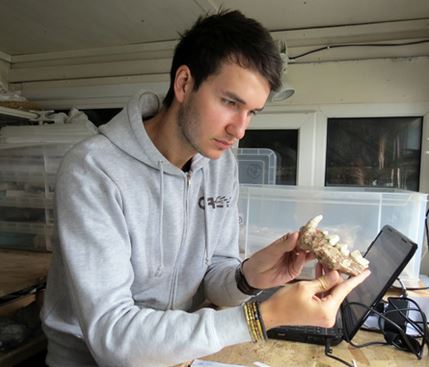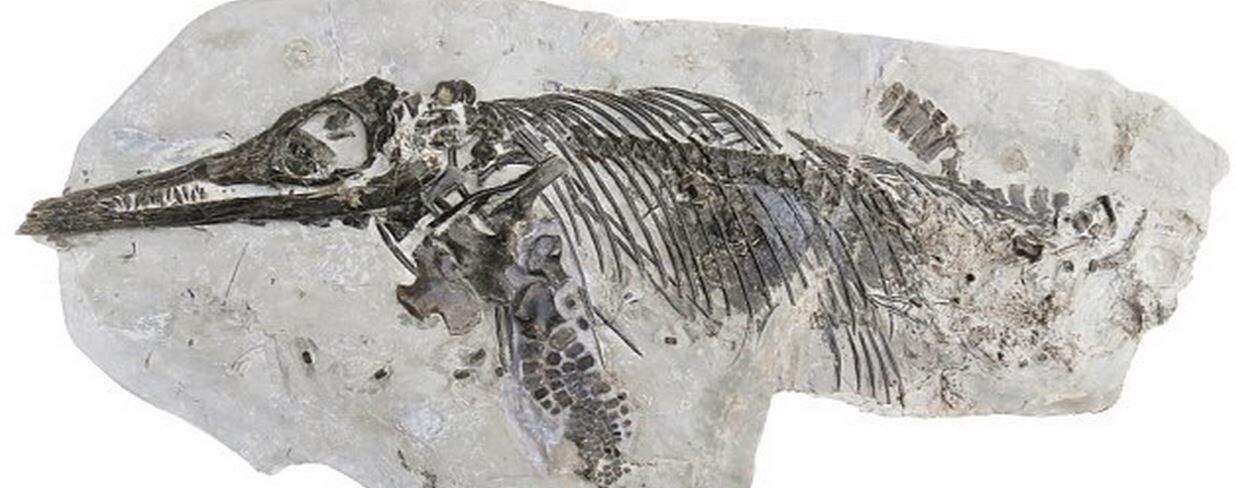A 189-million-year-old Ichthyosaur fossil that lay forgotten among lots of other specimens at the Doncaster Museum and Art Gallery in England, turned out to be the first new Ichthyosaur species discovered in the last 130 years.
Kept in storage for almost thirty years, Museum staff thought the five foot-long fossil, with its head intact, was a plaster copy.
Ichthyosaurs existed from 80 million to 250 million years ago, during the Triassic, Jurassic and Cretaceous periods. They were large marine reptiles that looked like sharks and dolphins and lived in salt water. They did not lay eggs – they gave birth to live young in the water. Scientists know this because they found fossils with the babies still inside the mother.

Thanks to Dean Lomax’ curiosity and persistence, we now know of another ichthyosaur species – ‘Ichthyosaurus anningae’.
In 2008, local palaeontologist, Dean Lomax, Honorary Visiting Scientist at The University of Manchester’s School of Earth Atmospheric and Environmental Sciences, took part in a project to revitalize the Museum’s fossil collection when he came across the specimen.
The fossil, nicknamed “Fizzy”, is about 183 million years old. What caught Mr. Lomax’ curiosity was that it had been found in a layer of rock not usually associated with ichthyosaurs.
Some abnormalities got the scientist wondering
He also noticed several abnormalities with the specimen’s bone structure, which made him think it might be something previously unidentified.
Mr. Lomax and Professor Judy Massare of Brockport College, part of the State University of New York, spent more than five years traveling across North America and the UK checking his findings.
A paper explaining the finding has been published in the Journal of Vertebrate Paleontology (citation below).
Mr. Lomax said:
“After examining the specimen extensively, both Professor Massare and I identified several unusual features of the limb bones (humerus and femur) that were completely different to any other ichthyosaur known. That became very exciting.”
“After examining perhaps over a thousand specimens we found four others with the same features as the Doncaster fossil.”

Ichthyosaurs, which have often been mistaken for ‘swimming dinosaurs’, swam in the seas for tens of millions of years before being wiped out. (Credit: James McKay. Image: University of Manchester)
The Doncaster fossil came from the Pliensbachian period. “Fizzy” is the most complete ichthyosaur in the world of this age.
Mr. Lomax added:
“The recognition of this new species is very important for our understanding of ichthyosaur species diversity during the early Jurassic, especially from this time interval.”
The researchers also looked at the age and size of the new species, and were able to tell males from females.
The study included comparisons with other living and extinct groups of reptiles whose limb bones are/were different between females and males, something that had never been applied to ichthyosaurs before.

Ichthyosaurus anningae fossil – the dark mass between the ribs are the remains of its last meal. (Image: University of Manchester)
Thanks to a generous donation by the Esmée Fairbairn Foundation to the Doncaster Museum Service, Fizzy’s limb bones were professionally prepared and removed.
Named in honour of Mary Anning
The new species has been named Ichthyosaurus anningae in honor of the famous fossil collector, dealer and palaeontologist Mary Anning (1799-1847). Ms. Anning is well nown for finds she made in Jurassic marine fossil beds in the cliffs of Lyme Regis (facing the English Channel). During her life, Ms. Anning had collected a large number of ichthyosaur fossils.
Mr. Lomax said: “Mary worked tirelessly to bring the ichthyosaurs, among other fossils, to the attention of the scientific world. Mary and her brother, Joseph, discovered the first ichthyosaur specimen to be scientifically recognised, collected at Lyme Regis around 1811.”
“It is an honour to name a new species, but to name it after somebody who is intertwined with such an important role in helping to sculpt the science of palaeontology, especially in Britain, is something that I’m very proud of. In fact, one of the specimens in our study was even found by Mary herself! Science is awesome.”
“This discovery shows that new species, and not only ichthyosaurs, are awaiting discovery in museum collections. Not all new discoveries are made in the field.”
Cllr Bob Johnson (Labour – Edlington & Warmsworth ward), Cabinet Member for Culture and Tourism, said:
“It’s wonderful that a new species has been discovered in Doncaster and some fantastic work has been done on this project. Fizzy is part of our fantastic fossil collection that visitors have said they want to see more of.
“Doncaster Museum and Art Gallery is a great family day out and Fizzy is just one of many attractions it is home to.”
Citation: “A new species of Ichthyosaurus from the Lower Jurassic of West Dorset, England, U.K.” Dean R. Lomaxab & Judy A. Massare. Journal of Vertebrate Paleontology. Published online: 19 Feb 2015. DOI:10.1080/02724634.2014.903260.

